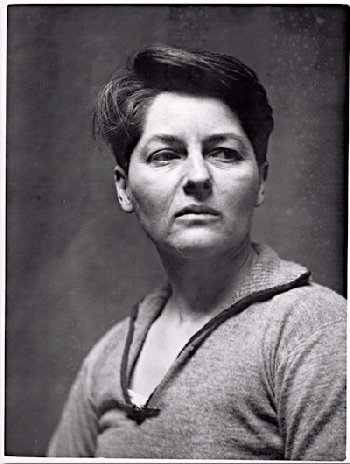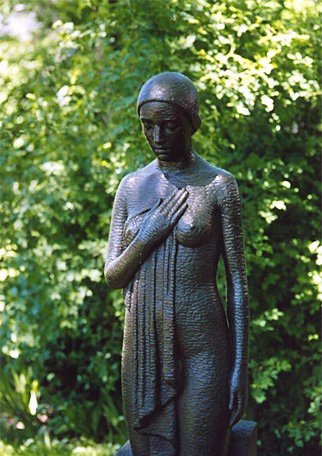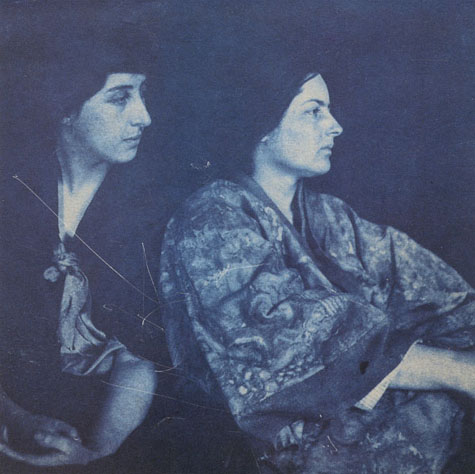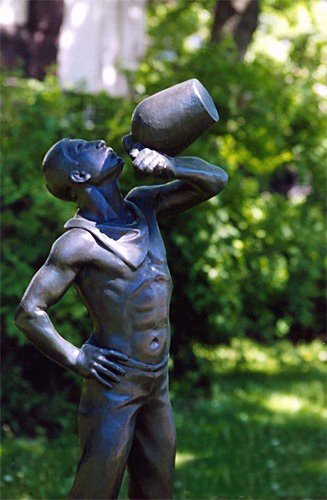| Florence Wyle
The Art History Archive - Biography & Sculptures
Born in Trenton, Illinois USA, Florence who had been studying sculpture for a few years, had originally set out to become a doctor, studying from 1900 to 1903 at the University of Illinois, in Urbana. She decided in the latter year to study art at the Art Institute of Chicago. It was a fateful decision both in terms of her professional and personal life, for there she met Frances Loring (1887-1968), in 1905, also a future sculptor and her lifelong companion. Her premedical studies and her profound respect for anatomical perfection had a significant effect on her work as one of Canada's finest academic sculptors. Florence went to Canada with Loring in 1913. Florence acknowledged the classical work of Greek sculptors and strived to create works that conveyed various aspects of the human condition. The realism and attention to detail apparent in her early sculptures, gave way to a more abstract and stylized treatment of the human form as her career progressed.
In 1938, Florence was the first woman sculptor to be accorded full membership in the Royal Canadian Academy [of Art]. In addition to this recognition, she received accolades throughout her career for such works as Torso (1930), a marble sculpture displayed at the National Gallery of Canada; Study of a Girl; and a series of decaying totems from the Skeena River area in British Columbia, which she was commissioned to replicate. Florence's extensive portfolio has been praised as rich, diversified, unique, timeless and powerful. Frances Loring and Florence Wyle are often profiled together because their personal and professional relationship spanned more than five decades. They competed for the same commissions and even collaborated on a few projects. They were also devoted to an ideal of classical sculpture that adhered to laws of composition, design and truth to nature. However, both Loring and Wyle's oeuvres maintain individual styles reflecting different sensibilities and emotions.
The 1930s and 1940s proved to be the height of the pair's artistic careers. Their work was honoured on many occasions, exhibitions were frequent and they actively participated in many associations and committees. During the 1950s however, they were eclipsed by a new generation of sculptors working in a tradition rooted in surrealism. Florence and Frances remained loyal to their vision of sculpture as a representation of life in three dimensions. They received fewer commissions and their popularity waned.
Florence Wyle died in Toronto in 1968, three weeks before Loring died. Each had a clause in her will whereby proceeds from the sale of their works would be added to a fund set up to purchase work by young sculptors. This fund, as well as their rich body of work, has had a significant impact on the art of sculpture in this country and continues to inspire both admirers and artists alike. Sculptures by Florence Wyle:
|
|
 Biography of Florence Wyle:
Biography of Florence Wyle:
 Florence preferred to work in bronze, but later developed an affinity for wood. Her Ten Rivers of America, consisting of a series of 10 torsos carved out of sumac, became the model for the Calvert Drama Trophies, which she designed along with Loring and Sylvia Daoust, a well-known Canadian wood carver. In contrast to Loring's monumental sculptures, Florence excelled in creating more intimate, detailed and refined pieces that captured her love of children, animals and nature. These themes are also evident in her poetry, which she published in Poems and in The Shadow of the Year.
Florence preferred to work in bronze, but later developed an affinity for wood. Her Ten Rivers of America, consisting of a series of 10 torsos carved out of sumac, became the model for the Calvert Drama Trophies, which she designed along with Loring and Sylvia Daoust, a well-known Canadian wood carver. In contrast to Loring's monumental sculptures, Florence excelled in creating more intimate, detailed and refined pieces that captured her love of children, animals and nature. These themes are also evident in her poetry, which she published in Poems and in The Shadow of the Year.
 In 1920, Florence and Frances moved into an old abandoned church. This location became their home and their studio. It also became a gathering place for Toronto's artistic community and the headquarters of the Sculptors' Society of Canada (SSC). They were founding members of the SSC when it was incorporated in 1928. The association's goal was to promote Canadian sculpture nationally and internationally by fostering professional standards, teaching appreciation, advising on public sculpture and organizing exhibits to enhance the visibility of sculpture as an art form.
In 1920, Florence and Frances moved into an old abandoned church. This location became their home and their studio. It also became a gathering place for Toronto's artistic community and the headquarters of the Sculptors' Society of Canada (SSC). They were founding members of the SSC when it was incorporated in 1928. The association's goal was to promote Canadian sculpture nationally and internationally by fostering professional standards, teaching appreciation, advising on public sculpture and organizing exhibits to enhance the visibility of sculpture as an art form.
 Nevertheless, in 1962, the London Public Library and Art Museum organized "Fifty Years of Sculpture," a traveling retrospective exhibition showcasing Loring and Wyle. This exhibition provided Canadians with a unique opportunity to view the work of two of this country's most talented and respected sculptors.
Nevertheless, in 1962, the London Public Library and Art Museum organized "Fifty Years of Sculpture," a traveling retrospective exhibition showcasing Loring and Wyle. This exhibition provided Canadians with a unique opportunity to view the work of two of this country's most talented and respected sculptors.